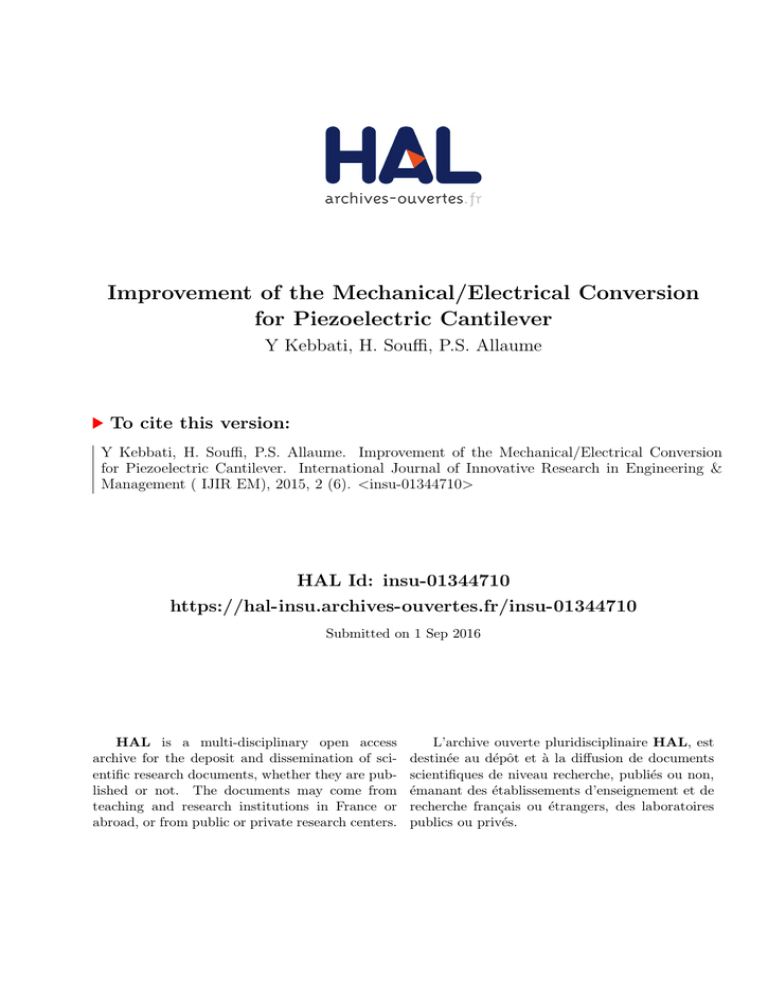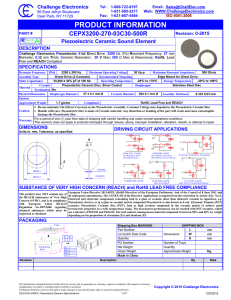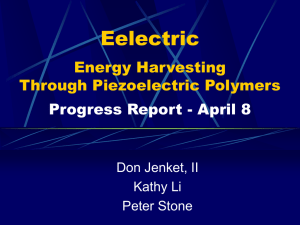Improvement of the Mechanical/Electrical Conversion - INSU
advertisement

Improvement of the Mechanical/Electrical Conversion for Piezoelectric Cantilever Y Kebbati, H. Souffi, P.S. Allaume To cite this version: Y Kebbati, H. Souffi, P.S. Allaume. Improvement of the Mechanical/Electrical Conversion for Piezoelectric Cantilever. International Journal of Innovative Research in Engineering & Management ( IJIR EM), 2015, 2 (6). <insu-01344710> HAL Id: insu-01344710 https://hal-insu.archives-ouvertes.fr/insu-01344710 Submitted on 1 Sep 2016 HAL is a multi-disciplinary open access archive for the deposit and dissemination of scientific research documents, whether they are published or not. The documents may come from teaching and research institutions in France or abroad, or from public or private research centers. L’archive ouverte pluridisciplinaire HAL, est destinée au dépôt et à la diffusion de documents scientifiques de niveau recherche, publiés ou non, émanant des établissements d’enseignement et de recherche français ou étrangers, des laboratoires publics ou privés. International Journal of Innovative Research in Engineering & Management (IJIREM) ISSN: 2350-0557, Volume-2, Issue-6, November- 2015 Improvement of the Mechanical/Electrical Conversion for Piezoelectric Cantilever Y. Kebbati H. Souffi Université d’Orléans/ Laboratoire de Laboratoire de Physique et Chimie Physique et Chimie de de l’Environnement et de l’Espace, l’Environnement et de l’Espace, Orléans, France, Orléans, France, P. S. Allaume Université d’Orléans, Orléans, France, ABSTRACT Table 1. Piezoelectric constitutive equation symbols In this paper, we present the optimization of the energy harvesting in the case of piezoelectric converter. In fact, the conversion of mechanical energy from environmental vibrations into electrical energy is a key point for powering sensor nodes, toward the development of autonomous sensor systems. Piezoelectric energy converters realized in a cantilever configuration are the most studied for this purpose. In order to improve the performances of the converter, the polarization was specially studied with FEM simulations. A parametrized model was created. The electrical energy generated by the converter under an applied force was computed. The experimental results were shown for ceramic PZT. T Stress CE Elasticity matrix (rank 4 tensor) S Strain E Electric field e Coupling matrix (rank 3 tensor) D Electric displacement ε Permittivity matrix (rank 2 tensor) Keywords 2. THE INTEREST TO POLARIZE A PIEZOELECTRIC ELEMENT Ceramic PZT, conversion of mechanical energy, piezoelectric energy converter, polarization enhancement. A number of crystals present a piezoelectric behavior; we can quote the quartz, the tourmaline, the salt of Seignette, the sugar… This behavior appears in crystals presenting an asymmetric structure and ionic connections; it can be described by observing the figure 1, which represents a view of the structure of the quartz. If we apply an effort, mechanical constraints which appear in the material cause distortion of its crystalline structure and so relative movement of the electric charges of the ions. These movements correspond to an electric polarization in the material. 1. INTRODUCTION Within power electronic electromagnetic transformers have been the dominating component for converting and transforming of electrical power. The trend of power converters goes in the direction of higher efficiency and smaller volume. Research has shown that piezoelectric converters (PC) can compete with traditional electromagnetic transformers on both efficiency and power density [1-4]. PCs are therefore an interesting field of research. A PC cantilever model includes the inverse and direct piezoelectric effect which harvesting the energy from the motion. The piezoelectric constitutive equations [5] in stress-charge form are given by couple of equations (1) and (2). These equations describe the relation between stress-charge form and stain-charge form. The symbols are explained in Table 1. Mechanical or electric effort Electrodes Equations 1: stress-charge form T = cE. S – e T. E Electrodes D = e . S + εS . E Figure 1. Cutting of an elementary cell of a quartz crystal under the effect of a mechanical or electric effort Equations 2: strain-charge form Unlike the crytals which the structure is fixed, the piezoelectric ceramic has a crystallography structure that can vary. An important family of piezoelectric ceramic, most used in industry, is the PZT (Lead-Zirconate-Titanate) which possess excellent piezoelectric properties. The PZT is generally formed by cristals of Lead Zirconate Pb2+Zr4+O32- and by Lead Titanate Pb2+Ti4+O32-, in near equal proportions [6]. The Titanate of Barium S = SE . T + dT . E D = dT + εT. E 30 Improvement of the Mechanical/Electrical Conversion for Piezoelectric Cantilever Ba2+Ti4+O32- is another piezoelectric ceramic which possesses the same crystallography structure as the PZT. with sinusoidal polarization without polarization x 10-3 Open circuit voltage [V] Fig. 2 (a) shows the structure of a PZT. Under the influence of a vertical electric polarization, we observe a stretching in polarization axis and a contraction in the orthogonal directions (figure 2 (b)). On the other hand, if we apply an orthogonal field, we obtain a cutting of the material (figure 2 (c)). qE qE time [S] (a) (b) (c) Figure 2. (a) Structure of the PZT without electric field. (b) Distortion of the structure with vertical applied field. (c) Distortion when othogonal field is applied. (a) with DC polarization without polarization Althought, ceramic PZT are used in a broad range of applications due to their excellent properties, such as high sensitivity, ease of manufacture and the possibility of poling the ceramic in any direction, they are very fragile and their piezoelectric parameters are sensitive to the temperature and can evolve in the time [7]. To increase the mechanical/electric conversion, the polarization of ceramic allows obtaining an initial geometrical distortion which will be added to the external distortion (stress). The result is an enhancement of energy harvesting without risk of mechanical destruction of the ceramic. 3. FEM SIMULATIONS The model uses a piezoelectric application mode for the simulation of the mechanical and the electrical behavior of the converter when sinusoidal vertical (z-axis) acceleration about 0.9m.s-2, 50Hz is applied. The polarization direction of piezoelectric is along the y-axis. First, we applied a sinusoidal polarization 10V, 50Hz and secondly a 10V DC polarization. The piezoelectric material parameters are derived from Ferroperm’s PZ26 [8]. The piezoelectric geometry is described in [8] and the layer thickness is fixed to 200µm. (b) Figure 3. Open circuit voltage when a sinusoidal vertical acceleration, with a magnitude of 0,9 m/s-2 and frequency of 50Hz, is applied to the cantilever Fig. 3 shows the open circuit voltage when the vertical acceleration is applied. With the sinusoidal polarization, figure 3 (a), the output voltage is higher than that obtained without polarization. However in comparison with the DC polarization, this output voltage is lower. In fact, the output voltage reaches its peak with DC polarization. The increase of the tension reaches nearly 10-3 Volt as shown in figure 3 (b). 4. EXPERIMENTAL RESULTS The experimental validation is realized using test bench with laser, lenses, reflector, photo receiving cell and PZT system as shown in figure 4. The PZT system is composed: ceramic PZT with 280 multilayers of 60 µm thickness each, an electronic circuit supplying polarization in the ceramic PZT and an actuator which applies mechanical stress. The photo receiving cell measures the movements of the PZT, whereas energy harvesting is converted in volt. From FEM simulations, we saw that the sinusoidal polarization gives poorer results compared to DC polarization. Thus, the experimental tests will be only made for DC polarization. 31 International Journal of Innovative Research in Engineering & Management (IJIREM) ISSN: 2350-0557, Volume-2, Issue-6, November- 2015 5. CONCLUSION Photoreceiving cell Electronic board Lenses This paper shows how polarization can be used to optimize the energy conversion for PZT. A simulation model was developed to validate the idea. The experimental results show the enhancement of energy harvesting in the case of ceramic PZT multilayers. The sensibility of the PZT to the mechanical stress was increased by 18 %. The use of the PZT as sensor is improved. PZT system PZT included in PZT system REFERENCES [1] T. Bove, W. Wolny, E. Ringgaard, and K. Breboel, “New type of piezoelectric transformer with very high power density”, in Applications of Ferroelectrics, 2000, pp. 321-324 vol. 1 Reflector [2] A. M. Flynn and S. R. Sanders, "Fundamental limits on energy transfer and circuit considerations for piezoelectric transformers," IEEE Transactions on Power Electronics, vol. 17, pp. 8-14, 2002. Figure 4. Test bench The experimental results are shown in figure 5. As predicted with simulation, the polarization allows enhancement in energy harvesting. To reach the same energy, we need to increase the mechanical stress applied to the PZT through the actuator about 18%. However, this increase of the stress also increases risk of destruction of the micro layers in ceramic. [3] W. Shao, L. Chen, C. Pan, Y. Liu, and Z. Feng, "Power density of piezoelectric transformers improved using a contact heat transfer structure," IEEE Transactions on Ultrasonics, Ferroelectrics and Frequency Control, vol. 59, pp. 73-81, 2012. [4] E. Horsley, M. Foster, and D. Stone, "State-of-the-art piezoelectric transformer technology," in EPE, 2007, pp. 110. With polarization Without polarization [5] T. Andersen, M. A. E. Andersen, O. C. Thomsen “Simulation of Piezoelectric Transformers with COMSOL”, Proceedings of the 2012 COMSOL Conference in Milan. [6] A. H. Carim, B. A. Tuttle, D. H. Doughty, S. L. Martinez, “Microstructure of Solution-Processed Lead Zirconate Titanate (PZT) Thin Films” Journal of the American Ceramic Society, 1991. [7] Y. Kebbati, H. Souffi, M. Pyee, “Energy Harvesting Enhancement of a Piezoelectric Converter”, International Journal of Engineering and Applied Sciences, Volume 2, Issue 9, 2015. [8] Ferroperm. Available: http://www.ferroperm-piezo.com [9] M. Guizzetti, V. Ferrari, D. Marioli, and T. Zawada, “Thickness Optimization of a Piezoelectric Converter for Energy Harvesting” Proceedings of the 2009 COMSOL Conference in Milan. Figure 5. Experimental results 32






